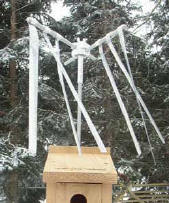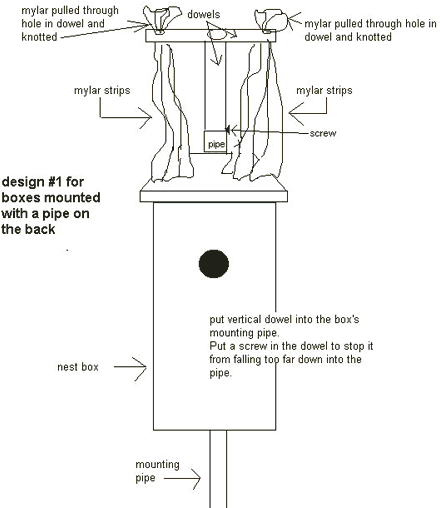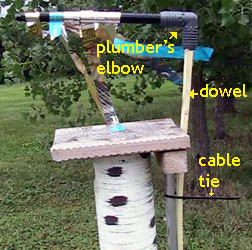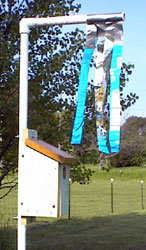QUICK TIP: Make a spooker so strips of mylar will flutter over the top of the nestbox (Design #2 or #4 recommended). Install the spooker immediately after the first egg is laid to deter House Sparrow attacks. Remove it (and the used nest) immediately after fledging to encourage another brood, and to avoid HOSP becoming accustomed to it.
DESIGNS AND INSTRUCTIONS
NOTE: If you have two boxes, and HOSP are building in one, and bluebirds in the other, either trap the HOSP, or addle the HOSP eggs, or wait until the first bluebird egg and spooker installation to start removing HOSP nests, to prevent HOSP from moving to the bluebird box before you can protect them.
Jump to: Timing | Designs | Instructions | Acceptance by bluebirds | Acceptance by other species | Reported Failures
A Sparrow Spooker is put over the roof of a nestbox to deter House Sparrows (HOSP). They are usually extremely effective in deterring HOSP from entering a bluebird nestbox to attack eggs, nestlings or incubating adults. You can’t watch the nest 24/7, but a sparrow spooker will protect it for you. It acts like a sort of force field. It is literally a life saver.
They are used on active nests of native birds in conjunction with other HOSP control measures. Sparrow spookers are one of the few passive HOSP controls that really work. Nothing (other than euthanasia) is guaranteed 100% effective against House Sparrows, but these come close if properly installed after the first egg and removed after fledging.
(Note: If the only control measures you take are are removing HOSP nests and eggs, it is POSSIBLE that such actions can stimulate extreme aggression and a HOSP may overcome its fear of the spooker. I had this happen on one occasion on an experimental trail where I was not trapping HOSP.)
Timing: Ideally, put the sparrow spooker up after egg laying begins, but before incubation begins to protect unattended eggs, and give the parents more time to accept the addition so incubation is not interrupted (eggs can chill). If you put it up while eggs are still being laid (they lay one a day, and incubation does not begin until a full clutch), you will have confirmation (with a new egg the next day) that the spooker has been accepted. See discussion on why you should wait till the first egg.
If the babies have already hatched and HOSP are in the area, I would recommend putting up a spooker later rather than not all. But try to do it in the morning when it is not too windy, and observe for up to an hour to verify acceptance. (The female may accept it more quickly than the male – fear of new things tends to be individual and species-dependent.)
If you have two boxes, and HOSP are building in one, and bluebirds in the other, either trap the HOSP, or wait until the first bluebird egg and spooker installation to start removing HOSP nests, to prevent HOSP from moving to the bluebird box before you can protect them.
Remove the spooker as soon as the babies fledge to encourage another brood AND to avoid HOSP getting used to it, which will destroy the effectiveness of one of the best HOSP-deterrents we have.
DO NOT USE A SPOOKER ON AN ACTIVE HOSP NEST. It will only “teach” the HOSP to accept it (as they will probably overcome their fear to get to their eggs/young.) Then you will lose one of the only tools that usually works to repel HOSP.
Design: Several designs are shown below, but all have material that flaps over the roof (barely brushing it – i.e., when it’s not windy they touch the top of the roof), near the entrance hole. For some reason, like monofilament, this “spooks” HOSP, but does not discourage bluebirds from entering the box once they have started laying. In fact, after awhile blues may even perch on the spooker.
 |
 |
See instructions below on how to make a spooker.
A ready-made, weather-resistant Sparrow Spooker is now commercially available from Sparrowtraps.net. This spooker is readily mounted on any style box. The height and spread of the “V” shape are adjustable. it comes with two mounting brackets so you pop it on the box that is “chosen” as soon as the first egg is laid. It comes with a roll of Mylar tape that you can cut to size and clip on the horizontal bars. Bluebird landlords were involved in its design. To keep it from spinning, put a little duct tape around the rod where it goes through the white holder. Photos courtesy of Sparrowtraps.net. |
| Sparrow Chaser made by Gene Wasserman, sold through the Michigan Bluebird Society. Easy to install – I am testing them now. Mounts on the back of the box/roof edge, uses bird scare tape that attaches to a wire circle above the roof. | Sparrow Shield made by Gene Wasserman, sold through the Michigan Bluebird Society. Easy to install – I am testing them now. Mounts on the back of the box/roof edge, uses thick flourescent wire. Intended to function like a Magic Halo, which was developed to keep HOSP away from bird feeders. | |
| Design #1 using “T” shape. I definitely recommend modifying this so the mylar hangs down from something parallel to the roof. | Design #2 (typical) with dowels in a “V” shape, and mylar flapping above and near entrance hole. THIS IS MY FAVORITE SPOOKER, and HAS NOT BEEN DEFEATED TO MY KNOWLEDGE. | |
 |
 |
|
| Design #3 using flagging material on a stick or pole. Streamers may not consistently get close enough to entrance hole so this design may be less effective in my opinion. NOT RECOMMENDED as it sometimes fails – only shown here for historical purposes as it was the original concept. | Design #4 for Gilbertson Box. Long, thin piece of scrap wood/dowel (tied to pole with plastic cable tie), with plastic elbow and a short piece of lightweight metal tubing jammed down over the dowel. | |
 NOT RECOMMENDED. Not as effective as designs where streamers brush the roof and hang from something parallel to the roof. NOT RECOMMENDED. Not as effective as designs where streamers brush the roof and hang from something parallel to the roof. |
 |
|
| Design #5. Tinsel wands used as party favors or children’s toys can also be used as sparrow spookers. Tape it to the box post, above the box. (Rose Bragg of the Bluebird Restoration Society of Wisconsin) If necessary, trim the tinsel so it just brushes the roof. | Design #4 on NABS-style box with plumber’s elbow and PVC pipe. (Note: I think the mylar should be on top of the roof, barely brushing it, so it moves readily in the wind, and over the roof itself. This one is probably taller than it needs to be.) | |
 Temporary spooker made out of cut up foil popcorn bag, duct tape, coffee stirrers and sticks. It worked! Temporary spooker made out of cut up foil popcorn bag, duct tape, coffee stirrers and sticks. It worked! |
 Another view of Design #4, made with PVC. Another view of Design #4, made with PVC. |
|
Materials: Sparrow spookers are not only effective, they are cheap to make.
Instructions for making a sparrow spooker:
Acceptance by Bluebirds: Different species and different individuals of the same species behave different, and may react differently to anything noticeably new. By putting the spooker up after the first egg is laid (egg laying typically occurs in early morning, before 1 p.m.), you will have confirmation of acceptance (and will not have to worry about interrupting incubation), as long as a new egg is laid the next day. You will also be protecting the nest while it is unoccupied, since the female does not begin incubating the eggs until she finishes laying all her eggs. If desired, observe the box after installation. In my experience, the female usually accepts it almost immediately–it may take the male 10-30 minutes. Males have been seen grabbing the end of a piece of mylar and shaking it or pulling on it right after installation.  It would be unusual for a spooker not to be accepted within an hour or two. (I have heard of one instance where it was NOT accepted by the female, and she only returned to the box after the spooker was removed. That is why observation is useful.) Avoid installing the spooker when it is very windy, as this may affect acceptance. If they don’t seem to accept it right away, leave the spooker up but take a rubber band and bunch the streamers to the top post out of the way. Then let one or more of the streamers down every day to desensitize them. Can I put the spooker up before an egg is laid? Some people have so many problems with House Sparrows that they want to put a spooker up BEFORE an egg is laid. I do not really recommend it for these reasons:
Instead, I recommend monofilament (which reduces HOSP interest in a box if put up before the male ‘bonds’ with the box) and other methods (passive and active) in the interim. One person did report putting sparrow spookers on two nestboxes early – one during bluebird nest building (before egg was laid), and one before Tree Swallows occupied a box (the previous swallow occupant was killed by HOSP). In both cases, the bluebirds and Tree Swallows did accept the “early” spooker and went on to successfully nest. More data is needed on this practice. Another person left one up after fledging, and the bluebirds went on to build a second nest. However, see concerns above. We really do not know why the spooker or the magic halo deter HOSP and not other birds. Perhaps as seed eaters, their vision is not as good as birds that are predominantly insect eaters. When placed on a mealworm feeder, a spooker was not accepted by blues. A Magic Halo is a better choice for a FEEDER – it is NOT intended for use on a nestbox. If the spooker is on a box in a public place, you might want to thumbtack or staple a laminated message to the box for educational purposes: “The mylar “sparrow spooker” above this box is meant to keep nonnative House Sparrows from killing the Tree Swallow adults/eggs/nestlings that occupy this nest box.” Failures: I have heard of the following instances of spookers failing:
A Spring 1995 issue of Sialia contained a report that Wayne Davis and Beth Blankenship experimented with four streamers made of plastic flagging, hung from the front of the roof of slot boxes. With this set up, the bird would have to go in between the flagging to enter the box. No deterrent effect was observed either on bluebirds or HOSP.
A sparrow spooker is an invaluable tool to protect nesting bluebirds. However, nothing besides trapping and elimination is foolproof. To effectively manage HOSPs, I recommend using a combination of passive and active control techniques. Sources and Acknowledgements:
|
– Mark, Wildlife Gardeners, 2009

